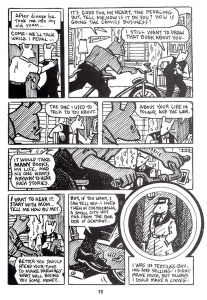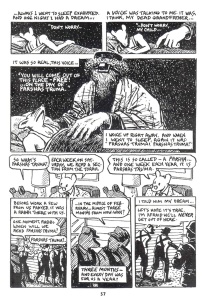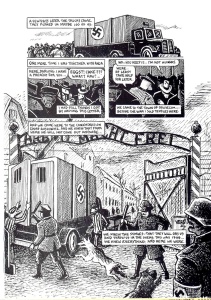Maus: Flash Back to the Present
Survivor Memory into Holocaust Art, Part I
History’s Limits
Elie Wiesel encapsulates the problem of Holocaust art by insisting that “Auschwitz defies imagination and perception; it submits only to memory. It can be communicated by testimony, not fiction.” Art as an approach to the Holocaust would seem to be seriously misguided if not transgressive of memory. Nevertheless he admits that even a survivor’s attempt at retelling “escapes language,” and therefore, if “we are incapable of revealing The Event, why not admit it.” Yet there are demands of historical responsibility that survivors feel compelled to answer. Finally, in despair Wiesel demands that survivors must rise above such doubts because “the future depends on our testimony… we invoke the past to save the future… [in a] commitment to life and truth” (Wiesel, “Does the Holocaust Lie Beyond the Reach of Art,” New York Times, April 17, 1983).
Factual first person narratives that Wiesel grudgingly allows assume a powerful place in representations of the Holocaust. The authority of survivor testimony is crucial in the process of writing a history of the Holocaust because history is fundamentally based on fact that is as free of interpretation as is possible. The quest for meaning on the other hand, whether for historical or contemporary purposes, is a pursuit of an inherently different kind recognizing the role of interpretation. While Elie Wiesel as a self-appointed guardian of the memory of the Holocaust (or the impossibility of such a cogent memory) is “deeply saddened and worried” about Holocaust art, the production of such art has continued unabated over his objections. This kind of art is central to the search for meaning about the paradigmatic event of the twentieth century. Nonetheless such interpretation must be able to claim itself to be authentic, based on the facts of what occurred, if it is to be taken seriously.
Art Spiegelman’s Maus: A Survivor’s Tale marks an important rupture in the lineage of survivor testimony. It presents a narrative of survivor testimony through the lens of an adult child of a survivor in a highly unorthodox medium, an early example of the graphic novel or commix format. This represents a shift from authentic testimony to a profoundly mediated testimony. James E. Young in his work on memory and the Holocaust, At Memory’s Edge, observes that in Maus “testimony is an event in its own right…[and] also the central role he [the author, not the survivor] plays in this event.” This represents a shift in which the mediation becomes an impenetrable barrier to the testimony itself. This shift signals the historical reality of the death of more and more survivors, until the direct access to living testimony becomes an impossibility. It is this inevitable process that Spiegelman addresses and effectively challenges Wiesel. Once the survivors are all gone who will carry on the struggle to invoke the past to save the future. What will become of the truth’s commitment to life?
Maus: A Survivor’s Tale is a two-volume work of close to fifteen hundred comic book style frames that was finally published in 1992 after thirteen years of drawing, interviews and research. It is a vital link in the complex process of representations of the Holocaust. Maus transforms the historical process of testimony into an artistic process in the search for a larger meaning. With Maus the representation is based on a third person account of that memory’s transmission. Both the first and second volumes open with actual events in the author’s life establishing his voice as primary. This move from historiography based on closeness to the event to a cultural representation that claims integrity based on aesthetic insights and an acknowledgement of distance from the event is precisely what Spiegelman’s Maus confronts us with.
Maus as Disjuncture
Volume One begins shockingly with a quote from Adolph Hitler: “The Jews are undoubtedly a race, but they are not human.” This establishes the artist’s rationale to use mice to represent the Jews, subverting the Nazi image of Jews as vermin by adopting it, as many minorities adopt similar vilifications, as a badge of honor. Spiegelman retaliates within his own paradigm by casting the Germans as cats, the natural enemies of mice; the Poles as pigs, and the Americans as good-natured dogs.

The prelude to first volume, My Father Bleeds History (1930s-1944), shows Artie as a child in 1958. A minor event transpires with the young Artie and his father, Vladek, reacts by obsessively recalling his experience in the ghetto. In chapter one the time shifts twenty years later; Artie is now an adult who demands that his father tell his story. Vladek, on an exercise bicycle, begins the story of his life in Poland before the war. The central frame of the page shows Vladek on the bike, the tattooed number on his arm just visible. The present, pictured on the exercise bike, intrudes repeatedly as the narrative of Vladek’s pre-war past proceeds. Vladek himself attempts to censure Artie from including details of his personal past from the book he is working on. Artie’s acquiescence to his father’s demands makes him an accomplice in distorting history, which he betrays by reporting it to the reader. Spiegelman seems to question where our loyalties should lie; with the process of revealing the past in a complete testimony, or with the respect for parental wishes, and finally, respect for the dead.
Throughout the course of the entire narrative the past and present “collapse into each other” observes James Young. Pointedly we see in chapter two Vladek at the birth of his first son Richieu in 1938. He relates that the child did not survive the war and then immediately recalls Artie’s difficult birth after the war. The recounting of the event in the past upsets Vladek, pictured in the present at the kitchen table opposite Artie, and he knocks over his pills, loosing count. The struggle to keep memories in order and the ‘health’ in their recounting is metaphorically exposed in this incident. The narratives are deeply intertwined in countless ways throughout as the story continues of Vladek’s early marriage to Artie’s mother, Anja, and his textile business in Poland. The rise of the Nazis is glimpsed as he relates how he is drafted in the Polish army in 1939. Suddenly Vladek digresses with an of-repeated story of how he now has cataracts and recently was operated on to implant a glass eye. We are drawn relentlessly into Artie’s perception of his aging father as the shifting viewpoints are continually reflected in both narratives. It becomes hard to determine which narrative is the dominant one.

The third chapter continues with family squabbles between Vladek, his second wife Mala and Artie intertwined with the pre-war narrative as Vladek finds himself in the Polish army, shooting at the invading Nazis. He is captured by the Germans and interred in a work camp. In yet another disjuncture, Vladek describes the harsh regime of the camp, interjecting that “every day I bathed and did gymnastics to keep strong… and every day we prayed. I was very religious and it wasn’t else to do.” The mention of religiosity, combined with a Hebrew phrase in the panel, comes out of nowhere. On the next page, Vladek reports a dream he had in the work camp of his dead grandfather, an ancient mouse clad in tallis and tefillin, who predicts that he will be free “on the day of parshas Truma.” Spiegelman flashes back to the present to explain what this reference to the Jewish calendar means. Continuing the disjunction, Vladek relates that indeed he was released on the Saturday that coincided with the congregational Torah reading of parshas Truma. In what may stretch the credibility of his father’s testimony, he relates that he in fact married Anja on the week of parshas Truma in addition to the fact that Artie was born in 1948 in, yes, parshas Truma. The interjection of a Jewish religious perspective on this otherwise totally secular narrative lends yet another puzzling element to the existing complexity. Finally the chapter ends back in the family home in Rego Park, Queens with Vladek impulsively throwing Artie’s only coat into the garbage. His father’s puzzling action simply adds to the discord within their relationship.
Spiegelman, while explaining his use of animals instead of humans, maintains that these strategies “show the masking of these events in their representation.” Young further comments that thereby these masks are “drawing attention to themselves as such, never inviting us to mistake the memory of events for the events themselves.” It seems to me that Spiegelman’s method is more radical. His use of mice, pigs, etc is but part of an overall strategy of disruption that calls attention to the process of obtaining his father’s story every step of the way. He is insisting on distinguishing between the memory of the Holocaust that his father possesses and the mediation of that memory necessary to transmit it to an audience of the next generation.

The extent of such disruptions blossom in chapter five as Artie, seen in bed with his wife, gets a desperate call from his step-mother Mala. The aged Vladek has climbed out onto the roof in an attempt to fix the drainpipe of his Queens home. This bizarre episode segues into the four page “Prisoner on the Hell Planet,” a 1972 commix by Spiegelman that relates the suicide of his mother, Anja, in 1968. The narrative continues showing Vladek and Anja forced into a ghetto, then fleeing as fugitives and finally captured and deported to Auschwitz. Constantly interspersed is the contemporary relationship between Artie and his father that becomes more and more strident. The final revelation that Vladek, in his confusion and grief over the suicide of Artie’s mother, had burned her memoirs was too much for Artie. In the last frame of Part One Artie walks away from his father’s house muttering a terrible curse, perhaps the ultimate fracture of memory; “…murderer.”
Art Spiegelman’s Maus presents a deeply disturbing picture of how a survivor’s memory is transmitted to the next generation. Next week we will explore Volume Two that finally reveals the multiple survivors in this tale.
Note: I gratefully acknowledge insights from James E Young’s At Memory’s Edge published by Yale University Press, 2000.
Maus: A Survivor’s Tale
Volume One: My Father Bleeds History
Volume Two: And Here My Troubles Began
By Art Spiegelman, published by Pantheon Books, New York 1992